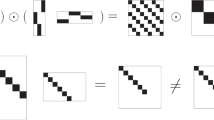Summary
We have determined the assay conditions necessary for quantifying the frequency of carcinogen-induced transformation of diploid human fibroblasts to anchorage independence. Emphasis is placed on the importance of using medium that supports clonal growth of the particular type of cells under investigation and titrating the percent of fetal bovine serum used in the assay to obtain a low, but measurable number of anchorage-independent colonies in the untreated control cultures. With this method, the target cells can be derived from adults as well as newborns and need not be in early passage, as long as they are able to grow vigorously.
Similar content being viewed by others
References
Anzano, M. A.; Roberts, A. B.; Sporn, M. B. Anchorage-independent growth of primary rat embryo cells is induced by platelet-derived growth factor and inhibited by type-beta transforming growth factor. J. Cell Physiol. 126:312–318; 1986.
Barrett, J. C.; Ts'o, P. O. P. Evidence for the progressive nature of neoplastic transformation in vitro. Proc. Natl. Acad. Sci. USA 75:3761–3765; 1978.
Bellett, A. J. D.; Younghusband, H. B. Spontaneous, mutagen-induced and adenovirus-induced anchorage independent tumorigenic variants in mouse cells. J. Cell. Physiol. 101:33–48; 1979.
Bouck, N.; diMayorca, G. Chemical carcinogens transform BHK cells by inducing a recessive mutation. Mol. Cell. Biol. 2:97–105; 1982.
Cox, R.; Masson, W. K. X-ray induced mutation to 6-thioguanine resistance in cultured human diploid fibroblasts. Mutat. Res. 37:125–136; 1976.
Freedman, V. H.; Shin, S. I. Cellular tumorigenicity in nude mice: Correlation with cell growth in semi-solid medium. Cell 3:355–359; 1974.
Fry, D. G.; McCormick, J. J. Unpublished studies.
Maher, V. M.; Dorney, D. J.; Mendrala, A. L., et al. DNA excision repair processes in human cells can eliminate the cytotoxic and mutagenic consequences of ultraviolet irradiation. Mutat. Res. 62:311–323; 1979.
Maher, V. M.; Rowan, L. A.; Silinskas, K. C., et al. Frequency of UV-induced neoplastic transformation of diploid human fibroblasts is higher in xeroderma pigmentosum cells than in normal cells. Proc. Natl. Acad. Sci. USA 79:2613–2617; 1982.
Maher, V. M. Unpublished studies.
McCormick, J. J.; Kateley-Kohler, S.; Watanabe, S. M., et al. Abnormal sensitivity of human fibroblasts from xeroderma pigmentosum variants to transformation to anchorage independence of ultraviolet radiation. Cancer Res. 46:489–492; 1986.
McCormick, J. J.; Maher, V. M. Measurement of colony-forming ability and mutagenesis in diploid human cells. In: Friedberg, E.C., Hanawalt, P. C., eds. DNA repair, A laboratory manual of research procedures, vol. 1B. New York: Marcel Dekker, Inc.; 1981:501–521.
McCormick, J. J. Unpublished studies.
McKeehan, W. L.; McKeehan, K. A.; Hammond, S. L., et al. Improved medium for clonal growth of human diploid fibroblasts at low concentrations of serum protein. In Vitro 13:399–416; 1977.
Milo, G. E.; Casto, B. C. Conditions for transformation of human fibroblast cells: An overview. Cancer Lett. 31:1–13; 1986.
Milo, G. E.; DiPaolo, J. A. Neoplastic transformation of human diploid cells in vitro after chemical carcinogen treatment. Nature 275:130–132; 1978.
Milo, G. E.; DiPaolo, J. A. Presensitization of human cells with extrinsic signals to induce chemical carcinogenesis. Int. J. Cancer 26:805–812; 1980.
Milo, G. E.; Oldham, J. W.; Zimmerman, R., et al. Characterization of human cells transformed by chemical and physical carcinogens in vitro. In Vitro 17:719–729; 1981.
Ozanne, B.; Wheeler, T.; Kaplan, P. L. Cells transformed by RNA and DNA tumor viruses produce transforming factors. Fed. Proc. 41:3004–3007; 1982.
Rizzo, A. Behavior of transforming growth factors in serum-free media: An improved assay for transforming growth factors. In Vitro 20:815–822; 1984.
Salmon, S. E., editor. Cloning of human tumor stem cells, Progress in clinical and biological research. New York: Alan R. Liss, Inc.; 1980:48.
Schaeffer, W. I. Usage of vertebrate, invertebrate and plant cell, tissue and organ culture terminology. Tissue Culture Rep. 17:19–23; 1983.
Sheela, S.; Kennedy, A. R. Radiation-induced anchorage independent growth and collagenase production in diploid human fibroblasts. Carcinogenesis 7:201–205; 1986.
Silinskas, K. C.; Kateley, S. A.; Tower, J. E., et al. Induction of anchorage independent growth in human fibroblasts by propane sultone. Cancer Res. 41:1620–1627; 1981.
Sutherland, B. M.; Cimino, J. J.; Delihas, N., et al. Ultraviolet light-induced transformation of human cells to anchorage-independent growth. Cancer Res. 40:1934–1939; 1980.
Sutherland, B. M.; Delihas, N. C.; Oliver, R. P., et al. Action spectra for ultra-violet light-induced transformation of human cells to anchorage-independent growth. Cancer Res. 41:2211–2214; 1981.
Tejwani, R.; Jeffrey, A. M.; Milo, G. E. Benzo(a)pyrene diol epoxide DNA adduct formation in transformable and nontransformable human foreskin fibroblast cells in vitro. Carcinogenesis 3:727–732; 1982.
Wang, Y.; Kateley-Kohler, S.; Maher, V. M., et al.60C Radiation-induced transformation to anchorage independence of fibroblasts from normal persons and patients with inherited prediposition to retinoblastoma. Carcinogenesis 7:89–93; 1986.
Author information
Authors and Affiliations
Rights and permissions
About this article
Cite this article
McCormick, J.J., Kateley-Kohler, S. & Maher, V.M. Methods for quantifying carcinogen-induced transformation of diploid human fibroblasts to anchorage independence. Journal of Tissue Culture Methods 10, 189–195 (1986). https://doi.org/10.1007/BF01405083
Issue Date:
DOI: https://doi.org/10.1007/BF01405083




